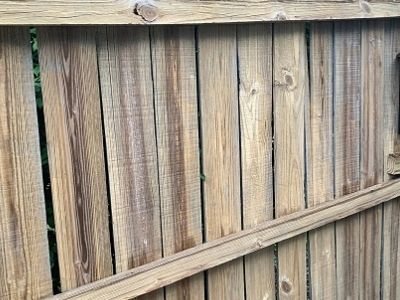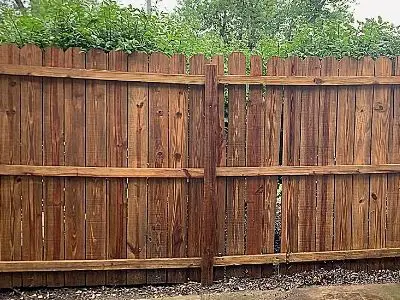*My posts may contain affiliate links, which means I may receive a small commission, at no cost to you, if you make a purchase through a link! Thank you for supporting my website!*
Last updated on February 29th, 2024 at 05:05 pm
Wondering if you have to stain or seal a fence after pressure washing? Look no further because I have your answer!
Staining a wood fence after pressure washing is not necessary. However, if the protective sealant was removed during pressure washing or one never existed, then sealing the fence is necessary to protect the fence from sun and moisture damage and keep the fence looking newer and more vibrant for longer.
I get it. After spending all of that time pressure washing, the last thing you want to do is go through the effort of staining and sealing a wood fence.
(At least, I didn’t haha!)
However, while it is not necessary to stain a fence after power washing, numerous benefits should persuade you to take a little bit of extra time now to protect your clean wood fence for years to come.
Let’s dive in!
Quick Navigation: What Happens If You Don’t Stain Or Seal Your Fence After Pressure Washing
- Enrich The Color & Wood Grain Of The Fence
- Protect The Fence From Sun Damage & Fading
- Minimize The Growth Of Algae, Mold, & Mildew
- Protect The Fence From Moisture & Water Damage
- Save Your Future Self Time & Money
- Other FAQs About Protecting A Fence After Pressure Washing
- Final Thoughts
One: Enrich The Color & Wood Grain Of The Fence
The first benefit of staining or sealing a fence after pressure washing is the enriched color and wood grain within the fence.
Typically, bare, unsealed, and unstained wood isn’t viewed as pretty because it’s dull and one-dimensional. And on the flipside, dirty, algae-covered wood that hasn’t been stained or sealed isn’t viewed as pretty either.
So it’s common to stain the wood to help pull out the beautiful wood grain within.
Although, if you do love the natural color of the wood fence, that’s okay!
It’s becoming more trendy to keep the natural color of the wood and just apply a sealer (or topcoat) to the wood.
Again, the idea is to enhance the color and grain of the wood, which helps add dimension to the wood and makes the wood appear “shiny and bright”.
These visually appealing benefits from applying stain or sealant help the fence stay looking brand new and well maintained for longer.

Two: Protect The Fence From Sun Damage & Fading
The next benefit of staining or sealing a fence after pressure washing is to protect the fence from sun damage and fading.
While the sun is a vital part of life on Earth, it tends to destroy anything that sits in its path for too long.
This is no different for an unprotected wood fence. If you leave a bare fence in the elements for too long, the wood can crack and splinter.
Eventually, pieces of the fence will break off and the structure of the fence will be compromised.

And even if you do stain your fence, the color won’t last long in the sun without a protective topcoat to prevent it from fading.
That being said, applying a sealant to your fence is necessary because it adds a protective layer between the fence and the sun’s harmful rays.
Much like us when we put sunscreen on to protect our skin, a solid sealant will protect your fence!
Three: Minimize The Growth Of Algae, Mold, & Mildew
The next benefit of staining or sealing a fence after pressure washing is that it minimizes the growth of algae, mold, and mildew.
Most exterior stains and sealants nowadays come with a mold and mildew resistance formula which is crucial to the long-term protection of your wood fence.
Over time, moisture from green algae causes splinters and breaks down the structural integrity of the wood. And while mold and mildew don’t directly harm the wood itself, they can be harmful to individuals who are allergic to the spores.

So applying a sealant with this formula is necessary to protect the life of your fence and also to protect anyone who will be around it frequently.
Also, a fence sealant with a mold and mildew resistance formula will save you so much time on maintaining the fence because you’ll have to clean it a lot less. Win-win for you!
Four: Protect The Fence From Moisture & Water Damage
The next benefit of staining or sealing a fence after pressure washing is that it protects the fence from moisture and water damage.
Other than the sun, water is a fence’s worst enemy. If you’ve had your fence for any number of years unprotected, then I’m sure you’ve seen the effects of water damage (specifically around the bottom of the fence posts).

The rainwater and moisture from green algae eat away at wood and can cause it to rot or fall apart over time.
The easiest way to prevent this is to apply a fence sealant to add a layer of protection between the wood and any water or moisture.
Without any water damage, the structure of the fence will last for decades and look much better as well.
Five: Save Your Future Self Time & Money
The last benefit of staining or sealing a fence after pressure washing is that it will save your future self some time and money.
I don’t know about you, but I am always trying to do things that will save my future self from financial and time burdens. (You could call it the lazy and frugal side of me sticking her two cents into things haha.)
So I am a big proponent of putting in the correct work upfront to reap the benefits for years into the future.
As we’ve discussed above, applying a high-quality fence sealant is the key to the long-term protection of your wood fence (which saves you money) and less maintenance over years (which saves you time).

The stain is mostly a cosmetic choice, so it’s up to you whether you choose to stain or solely seal your fence.
On the bright side, most exterior stains are a stain/sealant combination, so you can get the benefits of both with half the effort. (My kinda DIY project haha.)
The biggest benefit you’ll get from staining and/or sealing your wood fence after pressure washing is protecting future time and money.
That was enough to convince me to apply a sealant to my old, wood fence after I pressure washed it! And if you’re looking for step-by-step instructions on how to seal a fence, then you need to check out my tutorial here.
In 4 easy steps (or less!), you’ll save your future self a heck of a lot of time and money, and have a beautiful, easy-to-maintain wood fence for years to come!
Other FAQs About Staining/Sealing A Fence After Pressure Washing
Now that you understand the importance of staining and sealing a fence after pressure washing, let’s go over a few other questions you might be wondering about.
Then you’ll be ready to tackle this DIY project!
How Long After Pressure Washing Can You Stain A Fence?
After pressure washing a fence, allow the fence to completely dry before applying stain or sealant. Typically, a wood fence will dry fully in 24-48 hours. Staining or sealing a damp fence can result in a splotchy or uneven stain job, or the sealant taking longer to dry or not adhering to the fence properly.
Is It Better To Spray Or Roll Stain On A Fence?
When staining a wood fence, spraying stain helps cover hard-to-reach spots. However, rolling stain uses less stain overall than spraying and oftentimes can be applied quicker than a sprayer. Either way, both types of stain application will result in an even, uniform stain job.
For my fence, I used a foam roller and foam brush because they let me apply the stain super fast! (The brush helped me to get in the hard-to-reach spots between the panels.)
What Can I Use To Protect My Wood Fence?
To protect a wood fence, apply an exterior stain and sealer every couple of years. The sealer will protect the fence from moisture damage, sun damage, mold, and mildew, and will help showcase the vibrant wood color for longer. Valspar Pre-Tinted Semi-Transparent Exterior Wood Stain and Sealer found at Lowes is an excellent product to protect a wood fence.
That is the product we used on our wood fence, and we love how it turned out!
How Many Coats Of Stain Do I Need For A Fence?
To stain a wood fence, typically only one coat of stain is needed to achieve the desired color. However, if the color is too light, then apply a second coat after the first coat has dried thoroughly. Applying a wood conditioner before staining can help minimize the number of coats needed to stain a fence.
Final Thoughts On Staining/Sealing A Fence After Pressure Washing
There you have it! It’s definitely worthwhile to stain and/or seal a fence after pressure washing.
Specifically, because you’ve taken the time to pressure wash! Might as well protect all of that hard work and not let it go to waste.
Catch you in my next post!


By Christine
Christine is a blogger and DIYer who tackles home renovation and decorating projects alongside her husband, Adam, for their personal residence and rental properties. Although she successfully tackles large renovation projects to avoid expensive contractor fees and bring her vision to life now, her path to success was not easy.
Go here to read her story, “From a Clueless First-Time Homebuyer To A Confident DIYer Creating Her Dream Home One Project At A Time“.
Popular Posts
DIY With Christine is a participant in the Amazon Services LLC Associates Program, an affiliate advertising program designed to provide a means for sites to earn advertising fees by advertising and linking to Amazon.com.






